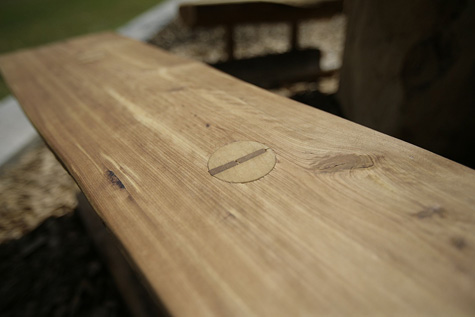
Sometimes there is the good way to do things, and then there is the best way.
Last spring, Donesh Ferdowsi, Parker Keyes and Yurina Kodama — all architecture majors in the Sam Fox School of Design & Visual Arts at Washington University in St. Louis — built dozens of outdoor benches for Patrick Henry Academy, an historic elementary school in downtown St. Louis.
Carved from rough stumps of cedar, oak and walnut, the benches are simply designed yet boast a telling detail: Legs attach to seat via “wedged through tenons.” It’s a complicated form of joinery, at once strong and elegant, long associated with Arts & Crafts furniture-making.
“It’s pretty, but it’s also very efficient,” says Keyes, who graduated in May. The joint itself becomes the decoration, showcasing the method of construction as well as the woods’ natural grain and color. “The wood informs the design.”
300,000 pounds of asphalt
The benches are just one facet of a semester-long studio led by Forrest Fulton, visiting assistant professor in the Sam Fox School’s College of Architecture. Fourteen students, working together and in teams of two and three, completed an ambitious slate of projects that have transformed an old cracked parking lot into open, inviting green space.
“We pulled out 300,000 pounds of asphalt,” Fulton says. “We planted nearly 30 trees and more than 300 plants. A 100-piece toy set was made, as well as 30 small seats and 24 seating arrangements.”
A cedar pavilion offers shade and a place to gather. Other projects include cast concrete tabletops and oaken play sculptures carved by chainsaw.
“It was a lot to get done, but it’s not just about the individual pieces,” Fulton says. “It’s about how they work together to create a very unique place.
“Look around,” he adds, gesturing to the street and the nearby houses and the enviable views of the Gateway Arch. “This place is part of St. Louis, part of the city fabric.
“It’s part of the neighborhood.”
CityStudioSTL
Fulton’s class was sponsored by CityStudioSTL, a collaborative program launched in 2011 by the Sam Fox School and the Skandalaris Center for Entrepreneurial Studies. Working with local groups and residents, students and faculty conceive, design and ultimately construct publicly minded projects.
The work at Patrick Henry represents “the second phase of a two-semester studio,” Fulton says.
Last year, students met with administrators, proposed designs and developed a master plan. They built pathways, planting beds and rolling earthen mounds covered with native grasses. They completed an “outdoor classroom,” installing rough-hewn limestone benches and a raised wooden walkway that doubles as a low stage.
All for a budget of about $60,000, mostly in donated goods and services.
This spring, students raised an additional $15,000 while also demonstrating their own considerable resourcefulness. For example, logs for the benches were rescued from local mulch piles and mined from the “free stuff” section of Craigslist.
“That’s part of the idea,” says graduate assistant Mikey Naucas, “to take things that are very rough but to finish them in ways that seem cared for and considered.”
Naucas (who wielded the aforementioned chainsaw) points to the shade pavilion, where a “roof” of white nylon, simple yet sturdy, floats in the breeze.
“It’s quite beautiful, actually.”
‘If we mess up …’
Ferdowsi, a Danforth Scholar who also graduated in May, observes that building something by hand is very different from designing plans or models in the studio.
“If we mess up here, there are real consequences,” Ferdowsi says. “We’ve just wasted $100, or $500, or a piece of material, or somebody’s time.
“What I learned from Forrest was how to create an environment in which it’s safe to fail — where that’s part of the learning process,” Ferdowsi says. “Embedded in every piece you see are 10 things that went wrong. Forrest’s cool demeanor helped us stay calm in those moments, and to figure out how to get things fixed.”
James B. Nesbitt, principal of Patrick Henry, notes that the CityStudioSTL work comes as part of the academy’s larger — and continuing — ambitions to re-invent itself as a green school.
So far, those efforts, in part, have netted awards from EcoLifeST and The Monsanto Fund. In March, CityStudioSTL won a merit award from the St. Louis Chapter of the American Society of Landscape Architects.
“From start to finish, this has been a wonderful project,” Nesbitt says. “The students have done a wonderful job.
“It’s a great addition to the school and the community as a whole.”